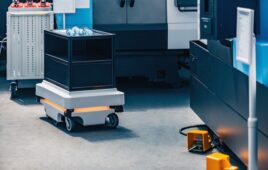Scientists at JET, the world’s largest fusion energy research facility, have been deliberately melting parts of their own machine as they test materials for the fusion reactors of the future. These apparent acts of scientific vandalism are actually courageous experiments which have yielded valuable information for JET’s successor – the huge international ITER project being built in the south of France.
The experiments were requested by ITER, which is currently assessing what material should be used for its plasma-facing wall. To achieve fusion, gas is heated to over one hundred million degrees, at which temperature it becomes a plasma, similar to the sun. Plasma is held inside a magnetic chamber known as a tokamak. Of particular concern to researchers are bursts of turbulence on the edge of the plasma similar to solar flares, which can momentarily inflict on to small areas of the tokamak wall heat loads far greater than a blow torch.
JET scientists have been astonished by the machine’s faultless performance during the recent tests.
“There was a slight worry we would see uncontrolled, firework-like splashes of molten metal,” said Dr Gilles Arnoux, one of the scientific coordinators of the experiment, “and that might affect subsequent experiments. But it was a smooth melt; the plasma didn’t seem to notice. I was surprised at how little impact it had.”
The tests at JET involved subjecting a small area of deliberately misaligned tungsten wall tile to regulated bursts of turbulent events. The peak temperature of the tile during the transient bursts was slowly increased until it exceeded tungsten’s melting point, 3422 degrees Celsius, to assess what effect molten tungsten might have on the operation of the plasma. In particular, it was feared that a melt event might contaminate the hydrogen-based plasma with tungsten and lead to a disruption – an uncontrolled energy dump from the plasma – which could lead to further surface melting in a fusion experiment as large as ITER.
Instead, as shown in the picture, the molten tungsten moved smoothly to one end of the tile and formed a droplet, that grew with each additional plasma pulse. Curiously the molten metal did not run downwards – a result of the magnetic forces inside the tokamak – and, to the scientists’ relief, moved away from the hottest part of the plasma rather than being swept back into the exposed area. Subsequent experiments were performed without any interruption to proceedings.
Joining the JET team in the control room was the leader of ITER’s Divertor and Plasma Wall Interactions section, Dr Richard Pitts, who has been involved throughout the planning of the experiment.
Dr Pitts said: “It has been a great success and has achieved what it set out to do: to demonstrate that repetitive, fast transient heat pulses pushing tungsten over the melt threshold for just a millisecond or two each time, do not drive melt splashing nor do they appear to have any observable effect on the core plasma. It seems that we can broadly understand what we have seen on the basis of complex computer simulations describing the melt dynamics and thus our confidence is increased in the extrapolations we make for the behaviour to expect on ITER, which use the same computer codes. These results are extremely significant for the choice which ITER is preparing to make regarding the use of tungsten.”
Despite the early optimism much analysis remains to be done. The full story will not be known until mid 2014, when JET’s current run of experiments concludes and the melted tile can be removed and analyzed.
For more information visit http://www.efda.org.
Filed Under: Industrial automation




